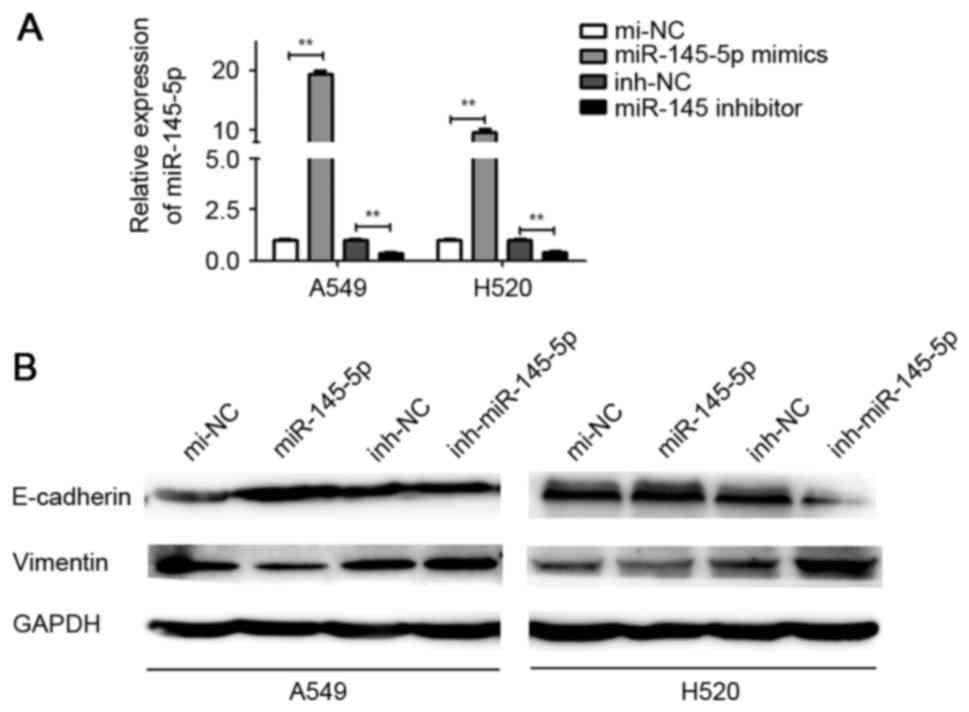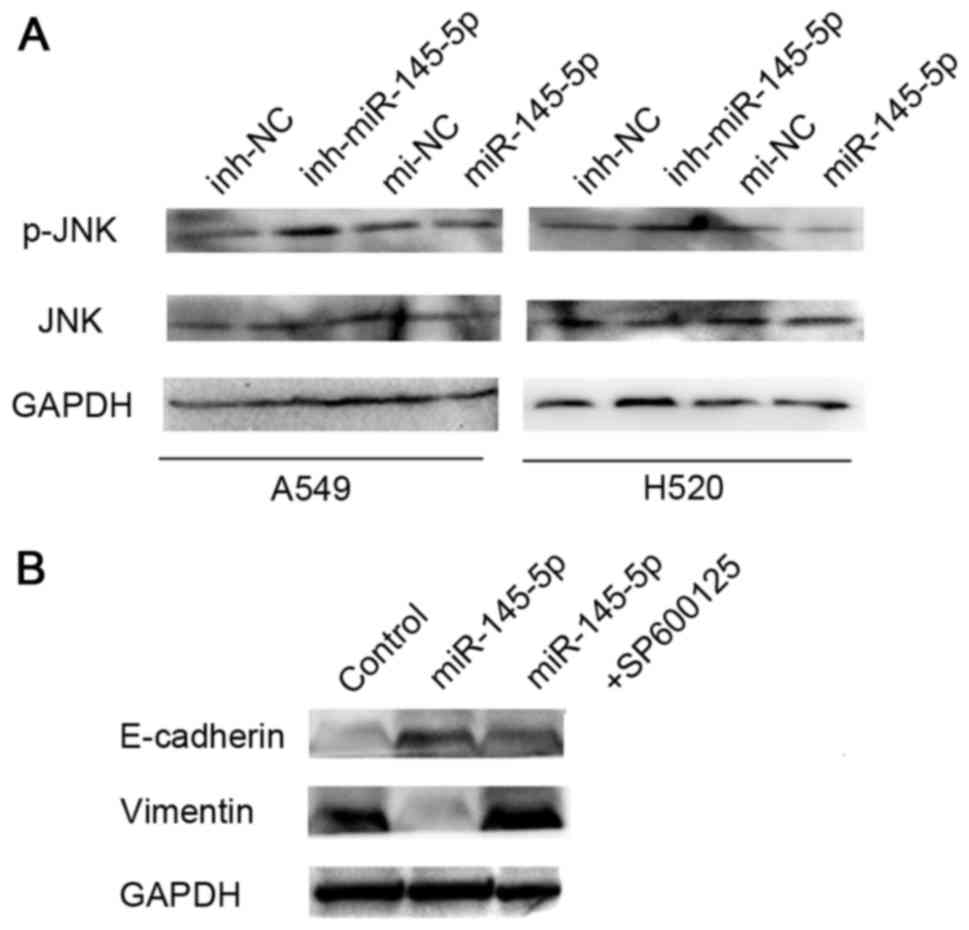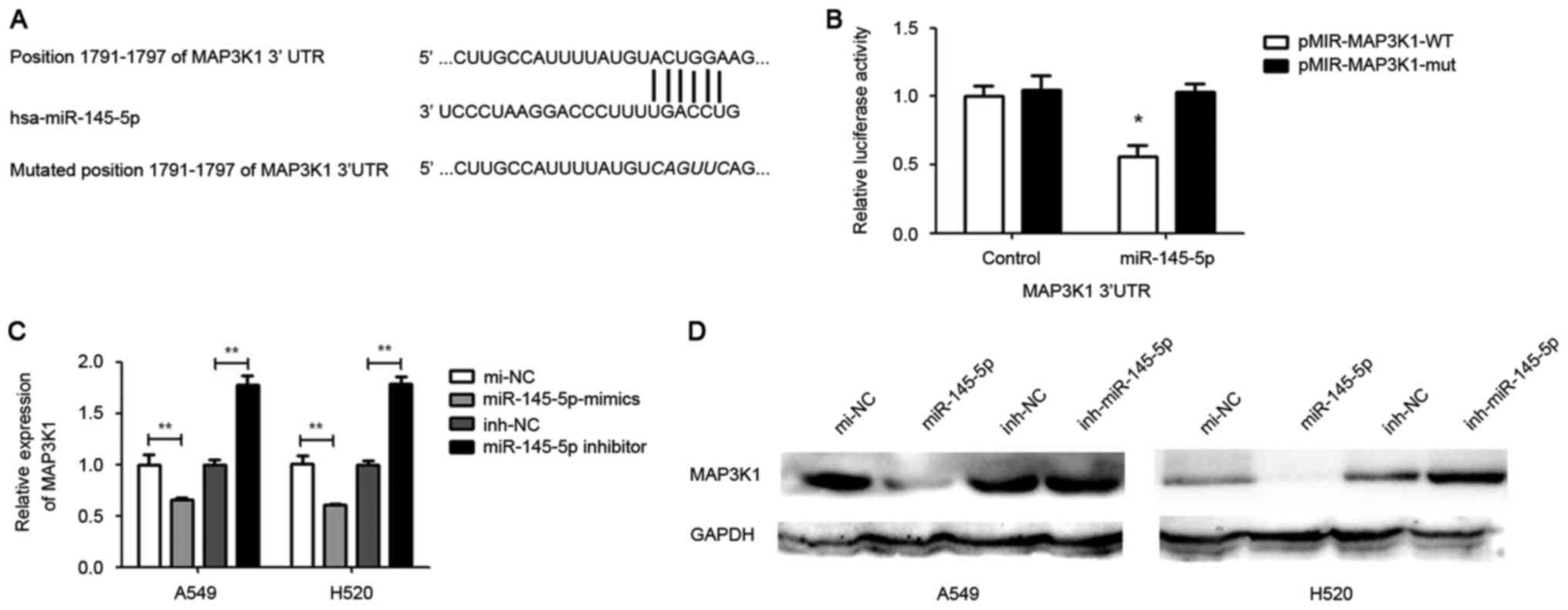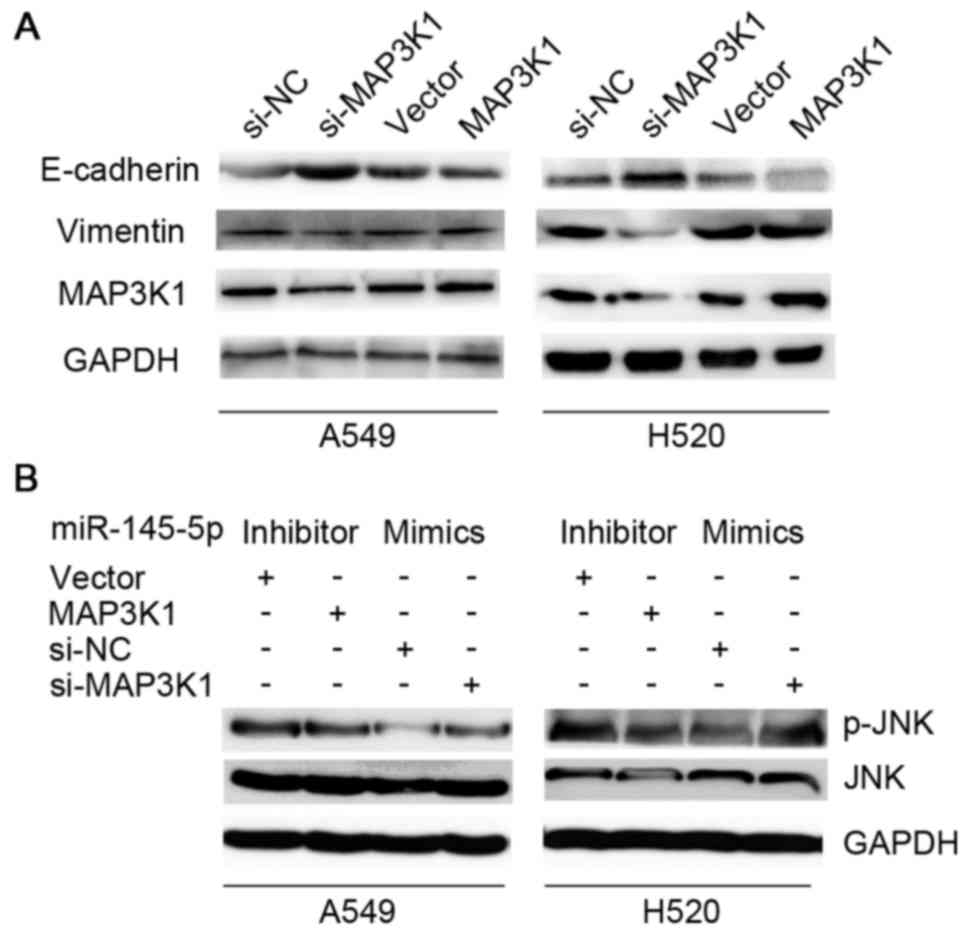miR‑145‑5p inhibits epithelial‑mesenchymal transition via the JNK signaling pathway by targeting MAP3K1 in non‑small cell lung cancer cells
- Authors:
- Published online on: September 28, 2017 https://doi.org/10.3892/ol.2017.7092
- Pages: 6923-6928
Abstract
Introduction
Lung cancer is one of the most common types of tumors and the leading cause of cancer-associated mortality in the world (1). Non-small cell lung cancer (NSCLC) accounts for ~80% of all lung cancer cases (2). Although many advances have been achieved in diagnosis and treatment and progress has been made in lung cancer therapy, there is ~5% improvement in 5-year survival rates for the previous 20 years (3).
Epithelial-mesenchymal transition (EMT) is an important cell biological process, which is associated with cancer migration, metastasis, asthma and fibrosis in the lung (4). When EMT occurs, epithelial cells gradually transform into mesenchymal-like cells by losing their epithelial-associated functions and characteristics (5). Epigenetic downregulation of E-cadherin expression was observed in advanced NSCLC and restoration of E-cadherin expression strongly suppressed the invasion/migration of tumor cells (6,7). Several signaling pathways are involved in EMT in NSCLC, including TGF-β (8), Slug (9), Wnt/β-catenin/zinc finger E-box binding homeobox 1 signaling (10) and c-Jun N-terminal kinase (JNK) signaling (11).
MicroRNAs (miRNAs) are small non-coding RNAs, which regulate gene expression post-transcriptionally. miRNAs are involved in the pathogenesis of lung diseases, including lung cancer, cystic fibrosis, chronic obstructive pulmonary disease, asthma and idiopathic pulmonary fibrosis (12). miRNAs contribute to the development of novel diagnostic biomarkers and personalized therapeutic tools in NSCLC (13).
miR-145 is silenced by DNA methylation and acts as a prognostic biomarker in NSCLC (14). miR-145 regulates chemoresistance in hepatocellular carcinoma (15) and bladder cancer (16) via EMT. miR-145 inhibits migration and invasion by down-regulating fascin actin-bundling protein 1 (FSCN1) (17) and mucin 1 (18).
The aim of the present study was to identify the function of miR-145-5p in EMT in NSCLC cells. In addition, it was investigated whether the target of miR-145-5p mediated this process. The findings of the present study will provide new insights into the functions of miR-145-5p as well as its molecular mechanisms in NSCLC.
Materials and methods
Cell culture and treatment
The NSCLC cell lines A549 and H520, and the normal lung bronchus epithelial cell line 16HBE were obtained from American Type Culture Collection (Manassas, VA, USA). The cells were grown in Dulbecco's modified Eagle's medium supplemented with 10% fetal bovine serum, 2 µM glutamine, 100 IU/ml penicillin, and 100 µg/ml streptomycin sulfate and were cultured in a humidified chamber with 5% CO2 at 37°C. All transfections were performed using Lipofectamine 2000 (Invitrogen; Thermo Fisher Scientific, Inc., Waltham, MA, USA). In order to interrupt the MAP3K1 mediated signaling pathway, cells were treated with 30 µm SP100625 (Enzo Life Sciences, Inc., Farmingdale, NY, USA) for 24 h.
Target prediction of miR-145-5p by Targetscan
Targetscan (http://www.targetscan.org/vert_71/) is an online software for the prediction of the binding of miRNAs to target genes. miR-145-5p investigated using the software to search for its target genes.
Transfection and apoptosis assay
The cells were placed in six-well plates at 70–90% confluence 24 h prior to transfection in serum-free media. The cells were transfected with plasmids, pcDNA3.1 or pcDNA3.1-MAP3K1 (2 µg/well; Fulengen, Guangzhou, China; http://www.fulengen.com/) or miRNA/small-interfering RNA (100 pmol/well) using Lipofectamine 2000, according to the manufacture's protocol. After 48 h, the cells were collected by trypsinization, washed with phosphate-buffered saline and used for subsequent experiments.
Luciferase reporter assay
The entire 3′-untranslated region (UTR) of human mitogen-activated protein kinase kinase kinase 1 (MAP3K1) was cloned by Genscript (Nanjing, China; http://www.genscript.com.cn/). The entire 3′-UTR of MAP3K1 were inserted into the pMIR-reporter plasmid (Ambion; Thermo Fisher Scientific, Inc.). The insertion was confirmed to be correct by DNA sequencing. The sequences that interact with the seed sequences of miR-145-5p were mutated. Luciferase assays were performed using A549 cells. The cells were transfected with: miR-145-5p mimics, 5′-GUCCAGUUUUCCCAGGAAUCCCU-3′ or scrambled sequences, 5′-UUCUCCGAACGUGUCACGUTT-3′; GenePharm, Inc. (Sunnyvale, CA, USA) and Renilla luciferase plasmids (Ambion; Thermo Fisher Scientific, Inc.) in 24-well plates. The cells were lysed for luciferase assay 48 h following transfection. Luciferase assays were performed using dual luciferase assay kit (Promega Corporation, Madison, WI, USA) according to the manufacturer's protocol.
Reverse transcription quantitative polymerase chain reaction (RT-qPCR)
Total RNA was extracted from NSCLC cell lines and 16HBE cells using TRIzol (Thermo Fisher Scientific, Inc.). Complementary DNAs were synthesized by using specific-miRNA primers (GeneCopoeia Inc., Guangzhou, China). The primers of miR-145-5p (HmiRQP0192) were obtained from Fulengen. U6 snRNA was used as an internal control. Gene expression levels were measured by RT-qPCR using BioRad CFX (Bio-Rad Laboratories, Inc., Hercules, CA, USA) and SYBR-Green kit (Takara Biotechnology Co., Ltd., Dalian, China). Reactions were incubated for 10 min at 95°C, followed by 40 cycles of 95°C for 10 sec; 60°C for 20 sec and 72°C for 10 sec. The primers of were as follows: MAP3K1 forward, 5′-TAGGGCCTAACTCTTTCCTGAT-3′ and reverse, 5′-GTTCTAGTTGAAACACCCGGA-3′; GAPDH forward, 5′-CAATGACCCCTTCATTGACC-3′ and reverse, 5′-GACAAGCTTCCCGTTCTCAG-3′. GAPDH was used as endogenous control to normalize the expression data. Reactions were incubated for 10 min at 95°C, followed by 40 cycles of 95°C for 10 sec; 60°C for 20 sec and 72°C for 15 sec. Each sample was analyzed in quadruplicate. The relative amount of miRNA was normalized to U6: Forward, 5′-CTCGCTTCGGCAGCACA-3′ and reverse, 5′-AACGCTTCACGAATTTGCGT-3′. The data was calculated with the equation 2−ΔΔCq, where ΔΔCq = (CqmiRNA - CqU6) target - (CqmiRNA - CqU6) control. Gene expression was calculated with the equation 2−ΔΔCq, where ΔΔCq = (Cqtarget - CqGAPDH) - (Cqcontrol - CqGAPDH) (19).
Western blotting
The cells were suspended in radioimmunoprecipitation assay protein lysis buffer (pH 7.4), containing 20 mM sodium phosphate, 150 mM sodium chloride, 5 mM EDTA, 5 mM phenylmethylsulfonyl fluoride, 1% aprotinin, 1 µg/ml leupeptin, and 500 µM Na3VO4. Protein concentration was quantified using Pierce BCA protein assay kit (Thermo Fisher Scientific, Inc.). Total protein (50 µg) was resolved with 6% SDS-PAGE, and transferred to a polyvinylidene difluoride membrane. Membranes were blocked in 5% non-fat milk diluted in TBST for 1 h at room temperature. The blots were probed with primary antibodies against MAP3K1 (cat. no. PA5-15085; Invitrogen; Thermo Fisher Scientific, Inc.), E-cadherin (cat. no. 14472), Vimentin (cat. no. 5741), JNK (cat. no. 9252), p-JNK (cat. no. 9255), GAPDH (cat. no. 5174) all purchased from Cell Signaling Technology, Inc., Danvers, MA, USA. All primary antibodies were diluted at 1:1,000 and incubated at 4°C overnight. After washing, membranes were probed with appropriate secondary antibodies, horseradish peroxidase conjugated-goat anti mouse IgG (cat. no. BA1051; Boster Biological Technology, Pleasanton, CA, USA) or horseradish peroxidase conjugated-goat anti rabbit IgG (cat. no. BA1054; Boster Biological Technology). Secondary antibodies were diluted at 1:5,000 and incubated at room temperature for 1 h. All membranes were stripped by incubating in Restore PLUS Western blot stripping buffer (Thermo Fisher Scientific, Inc.) for 15 min at room temperature and reprobed with anti-GAPDH antibody for loading control. The blots were visualized using enhanced chemiluminescence (GE Healthcare, Chicago, IL, USA).
Statistical analysis
Statistical analysis was performed with SPSS17.0 (SPSS, Inc., Chicago, IL, USA). The Student's t-test was used to compare the different groups. P<0.05 was considered to indicate a statistically significant difference, and P-values are represented by an asterisk on the bars in the figures.
Results
Ectopic expression of miR-145-5p inhibits EMT in NSCLC cells
The effect of miR-145-5p mimics and inhibitor transfection was detected (Fig. 1A). It was demonstrated that ectopic expression of miR-145-5p markedly increased the expression of E-cadherin and suppressed the expression of vimentin in A549 and H520 cells, compared with mi-NC. By contrast, depletion of miR-145-5p induced E-cadherin downregulation and vimentin upregulation in A549 and H520 cells (Fig. 1B).
Involvement of JNK signaling in miR-145-5p-induced EMT suppression in NSCLC
JNK is not required for initiation of NSCLC, but associated with EMT. JNK drives transcription of numerous key EMT genes (20). It has been reported that TGF-β1 induced JNK activation during EMT in idiopathic pulmonary fibrosis (21). In the present study, it was examined whether JNK signaling pathway has a critical role in the regulation of miR-145-5p-mediated EMT in NSCLC cells. The results revealed that overexpression of miR-145-5p was able to inhibit the expression of phosphorylated (p)-JNK, but has no effect on the level of total JNK protein (Fig. 2A). The cells were also treated with a combination of a specific JNK inhibitor (SP600125) and miR-145-5p. Western blotting analysis showed SP600125 was able to reverse the effect of miR-145-5p on EMT in A549 and H520 cells (Fig. 2B).
MAP3K1 is a target of miR-145-5p
TargetScan online software was used to search for putative protein-coding gene targets of miR-145-5p. The results indicated that MAP3K1 is a putative target of miR-145-5p (Fig. 3A). The MAP3K1 3′UTR was cloned into a luciferase reporter vector and binding sites of the mutant vector. The A549 cells were co-transfected with either mutated pmiR-MAP3K1-3′UTR and miR-145-5p mimics or wild-type pmiR-MAP3K1-3′UTR and miR-145-5p mimics. The cells were also co-transfected with mutated pmiR-MAP3K1 and negative control or wild-type pmiR-MAP3K1 and negative control. Luciferase activity was measured 48 h following transfection.
The results showed that the cells co-transfected with wild-type pmiR-MAP3K1-3′UTR and miR-145-5p mimic exhibited significant reduction in luciferase activity compared with cells cotransfected with the control. By contrast, the luciferase activity in cells transfected with mutated pmiR-MAP3K1-3′UTR and miR-145-5p mimic was not significantly altered (Fig. 3B). Furthermore, RT-qPCR and western blotting analysis was used to investigate the expression of MAP3K1 regulated by miR-145-5p in A549 and H520 cells. The results showed that a marked reduction in mRNA and protein level of MAP3K1 in miR-145-5p-overexpressed A549 and H520 cells compared with the control (Fig. 3C and D).
MAP3K1 reverses miR-145-5p- induced inhibition of EMT in NSCLC
Since MAP3K1 was a novel target of miR-145-5p in NSCLC cells, it was investigated whether the effect of miR-145 on EMT was mediated by MAP3K1. Fig. 4A showed that the knockdown of MAP3K1 markedly induced the expression of E-cadherin and inhibited the expression of vimentin in A549 and H520 cells, while overexpression of MAP3K1 treatment reversed this effect. The ectopic expression of MAP3K1 was able to partly reverse the downregulation of p-JNK induced by the miR-145-5p inhibitor compared to the vector group. While, the suppression of MAP3K1 was able to interrupt the upregulation of p-JNK induced by miR-145-5p mimics compared to the siRNA negative control group (Fig. 4B).
Discussion
EMT is a characteristic feature of the majority of metastatic cells (22). Epithelial cells are highly differentiated, polarized and organized. When EMT occurs, these cells are transformed into undifferentiated, isolated and mesenchymal-like cells (23). E-cadherin and vimentin are known to be closely associated with EMT (24). E-cadherin has important functions in regulating cell-cell interactions (25). Epigenetic silencing of E-cadherin expression was observed in advanced NSCLC, and restoration of E-cadherin expression strongly suppressed the metastasis of cancer cells (7). Vimentin is specifically expressed in normal mesenchymal cells and overexpressed in lung cancer cells (26). In previous studies, vimentin has been considered as a marker for EMT (26), and EMT is considered to be involved in the pathogenesis of lung cancer (5). Insulin like growth factor 1 receptor-induced resistance to epidermal growth factor receptor-tyrosine kinase inhibitors in advanced NSCLC is mediated by EMT (27). MARVELD1 suppresses EMT in NSCLC cells (28). Inactivation of M2 acetylcholine receptor/nuclear factor-κB signaling axis reverses EMT and suppresses migration and invasion in NSCLC cells (29).
miR-145 was reported to inhibit metastasis in multiple tumors, including hepatocellular carcinoma (30), osteosarcoma (31) and nasopharyngeal carcinoma (32). miR-145 inhibits migration and invasion by downregulating FSCN1 (17) and mucin1 (18). A previous study by the present authors revealed that miR-145 acts as a metastasis suppressor by targeting metadherin in lung cancer (33). miR-145 regulates chemoresistance in hepatocellular carcinoma via EMT (15). However, the underlying mechanisms of miR-145-5p in regulating EMT in NSCLC are unclear. In the present investigation, it was demonstrated that miR-145-5p increased the expression of E-cadherin and suppressed the expression of vimentin. Therefore, it was hypothesized that miR-145-5p may inhibit metastasis via suppressing EMT in NSCLC cells.
The JNK signaling pathway exert an important role in the function of NSCLC cells. It was previously demonstrated that protein 4.1N, a member of the protein 4.1 family, was able to suppress metastasis by inactivating JNK-c-Jun signaling pathway in NSCLC (34). Celastrol induces cisplatin re-sensitization through inhibition of the JNK/activating transcription factor 2 signaling pathway in NSCLC (35). JNK signaling mediates EPH receptor A2-dependent tumor cell proliferation, motility and cancer stem cell-like properties in NSCLC cells (36). miR-145 induces apoptosis in ethanol-induced acute gastric mucosal injury via the JNK signaling pathway (37). However, no studies have yet shown the association between miR-145-5p and the JNK signaling pathway in NSCLC.
In the present study, the effect of miR-145-5p on JNK signaling pathway in NSCLC cells was detected. The results showed that miR-145-5p was able to inactivate the JNK signaling pathway in NSCLC cells. The results of the present study are in accordance with previous research from another group (38).
MAP3K1 is a component of an evolutionarily conserved signal transduction cascade, which can activate mitogen-activated protein kinases (MAPKs) (39). It has been previously revealed that the single nucleotide polymorphism MAP3K1 rs889312 is closely associated with the risk of breast cancer and outcome among patients with diffuse-type gastric cancer (40).
In the present study, it was predicted and confirmed that MAP3K1 is a potential target of miR-145-5p. In order to clarify the function of MAP3K1 on EMT in NSCLC cells, the expression of E-cadherin and vimentin regulated by MAP3K1 was detected. The data illustrated that ectopic expression of MAP3K1 was able to inhibit E-cadherin protein levels and increase vimentin protein levels in NSCLC cells. Subsequently, whether MAP3K1 regulates ETM via a miR-145-5p mediated-JNK signaling pathway was investigated. The results revealed that overexpression of miR-145-5p and inhibition of MAP3K1 was able to reverse the expression of p-JNK in NSCLC cells. To conclude, miR-145-5p was able to inhibit EMT via JNK signaling pathway by targeting MAP3K1 in NSCLC cells.
Acknowledgements
The present study was supported by the Natural Science Foundation of Guangdong Province (grant no. 2016zc0160) and the Science and Technology Planning Project of Guangdong Province, China (grant no. 2014A020212447).
References
|
Hu J, Qiu M, Jiang F, Zhang S, Yang X, Wang J, Xu L and Yin R: MiR-145 regulates cancer stem-like properties and epithelial-to-mesenchymal transition in lung adenocarcinoma-initiating cells. Tumour Biol. 35:8953–8961. 2014. View Article : Google Scholar : PubMed/NCBI | |
|
Mariotto AB, Noone AM, Howlader N, Cho H, Keel GE, Garshell J, Woloshin S and Schwartz LM: Cancer survival: An overview of measures, uses, and interpretation. J Natl Cancer Inst Monogr. 2014:145–186. 2014. View Article : Google Scholar : PubMed/NCBI | |
|
Johnson DH, Schiller JH and Bunn PA Jr: Recent clinical advances in lung cancer management. J Clin Oncol. 32:973–982. 2014. View Article : Google Scholar : PubMed/NCBI | |
|
Tian L, Shen D, Li X, Shan X, Wang X, Yan Q and Liu J: Ginsenoside Rg3 inhibits epithelial-mesenchymal transition (EMT) and invasion of lung cancer by down-regulating FUT4. Oncotarget. 7:1619–1632. 2016. View Article : Google Scholar : PubMed/NCBI | |
|
Bartis D, Mise N, Mahida RY, Eickelberg O and Thickett DR: Epithelial-mesenchymal transition in lung development and disease: Does it exist and is it important? Thorax. 69:760–765. 2014. View Article : Google Scholar : PubMed/NCBI | |
|
Yuan X, Wu H, Han N, Xu H, Chu Q, Yu S, Chen Y and Wu K: Notch signaling and EMT in non-small cell lung cancer: Biological significance and therapeutic application. J Hematol Oncol. 7:872014. View Article : Google Scholar : PubMed/NCBI | |
|
Mateen S, Raina K, Agarwal C, Chan D and Agarwal R: Silibinin synergizes with histone deacetylase and DNA methyltransferase inhibitors in upregulating E-cadherin expression together with inhibition of migration and invasion of human non-small cell lung cancer cells. J Pharmacol Exp Ther. 345:206–214. 2013. View Article : Google Scholar : PubMed/NCBI | |
|
Qu MH, Han C, Srivastava AK, Cui T, Zou N, Gao ZQ and Wang QE: miR-93 promotes TGF-β-induced epithelial-to-mesenchymal transition through downregulation of NEDD4L in lung cancer cells. Tumour Biol. 37:5645–5651. 2016. View Article : Google Scholar : PubMed/NCBI | |
|
Wang LK, Pan SH, Chang YL, Hung PF, Kao SH, Wang WL, Lin CW, Yang SC, Liang CH, Wu CT, et al: MDA-9/Syntenin-Slug transcriptional complex promote epithelial-mesenchymal transition and invasion/metastasis in lung adenocarcinoma. Oncotarget. 7:386–401. 2016. View Article : Google Scholar : PubMed/NCBI | |
|
Qu J, Li M, An J, Zhao B, Zhong W, Gu Q, Cao L, Yang H and Hu C: MicroRNA-33b inhibits lung adenocarcinoma cell growth, invasion, and epithelial-mesenchymal transition by suppressing Wnt/β-catenin/ZEB1 signaling. Int J Oncol. 47:2141–2152. 2015. View Article : Google Scholar : PubMed/NCBI | |
|
Kim J, Moon SH, Kim BT, Chae CH, Lee JY and Kim SH: A novel aminothiazole KY-05009 with potential to inhibit Traf2- and Nck-interacting kinase (TNIK) attenuates TGF-β1-mediated epithelial-to-mesenchymal transition in human lung adenocarcinoma A549 cells. PLoS One. 9:e1101802014. View Article : Google Scholar : PubMed/NCBI | |
|
Ebrahimi A and Sadroddiny E: MicroRNAs in lung diseases: Recent findings and their pathophysiological implications. Pulm Pharmacol Ther. 34:55–63. 2015. View Article : Google Scholar : PubMed/NCBI | |
|
Feng B, Zhang K, Wang R and Chen L: Non-small-cell lung cancer and miRNAs: Novel biomarkers and promising tools for treatment. Clin Sci (Lond). 128:619–634. 2015. View Article : Google Scholar : PubMed/NCBI | |
|
Xia W, Chen Q, Wang J, Mao Q, Dong G, Shi R, Zheng Y, Xu L and Jiang F: DNA methylation mediated silencing of microRNA-145 is a potential prognostic marker in patients with lung adenocarcinoma. Sci Rep. 5:169012015. View Article : Google Scholar : PubMed/NCBI | |
|
Ju BL, Chen YB, Zhang WY, Yu CH, Zhu DQ and Jin J: miR-145 regulates chemoresistance in hepatocellular carcinoma via epithelial mesenchymal transition. Cell Mol Biol (Noisy-le-grand). 61:12–16. 2015.PubMed/NCBI | |
|
Tan J, Qiu K, Li M and Liang Y: Double-negative feedback loop between long non-coding RNA TUG1 and miR-145 promotes epithelial to mesenchymal transition and radioresistance in human bladder cancer cells. FEBS Lett. 589:3175–3181. 2015. View Article : Google Scholar : PubMed/NCBI | |
|
Zhang Y, Yang X, Wu H, Zhou W and Liu Z: MicroRNA-145 inhibits migration and invasion via inhibition of fascin 1 protein expression in non-small-cell lung cancer cells. Mol Med Rep. 12:6193–6198. 2015. View Article : Google Scholar : PubMed/NCBI | |
|
Ye Z, Shen N, Weng Y, Li K, Hu L, Liao H, An J, Liu L, Lao S and Cai S: Low miR-145 silenced by DNA methylation promotes NSCLC cell proliferation, migration and invasion by targeting mucin 1. Cancer Biol Ther. 16:1071–1079. 2015. View Article : Google Scholar : PubMed/NCBI | |
|
Livak KJ and Schmittgen TD: Analysis of relative gene expression data using real-time quantitative PCR and the 2(-Delta Delta C(T)) method. Methods. 25:402–408. 2001. View Article : Google Scholar : PubMed/NCBI | |
|
Sahu SK, Garding A, Tiwari N, Thakurela S, Toedling J, Gebhard S, Ortega F, Schmarowski N, Berninger B, Nitsch R, et al: JNK-dependent gene regulatory circuitry governs mesenchymal fate. EMBO J. 34:2162–2181. 2015. View Article : Google Scholar : PubMed/NCBI | |
|
Ding H, Ji X, Chen R, Ma T, Tang Z, Fen Y and Cai H: Antifibrotic properties of receptor for advanced glycation end products in idiopathic pulmonary fibrosis. Pulm Pharmacol Ther. 35:34–41. 2015. View Article : Google Scholar : PubMed/NCBI | |
|
Alizadeh AM, Shiri S and Farsinejad S: Metastasis review: From bench to bedside. Tumour Biol. 35:8483–8523. 2014. View Article : Google Scholar : PubMed/NCBI | |
|
Guan X: Cancer metastases: Challenges and opportunities. Acta Pharm Sin B. 5:402–418. 2015. View Article : Google Scholar : PubMed/NCBI | |
|
Qi D, Gill Kaur N, Santiskulvong C, Sifuentes J, Dorigo O, Rao J, Taylor-Harding B, Wiedemeyer Ruprecht W and Rowat AC: Screening cell mechanotype by parallel microfiltration. Sci Rep. 5:175952015. View Article : Google Scholar : PubMed/NCBI | |
|
Zheng H and Kang Y: Multilayer control of the EMT master regulators. Oncogene. 33:1755–1763. 2014. View Article : Google Scholar : PubMed/NCBI | |
|
Satelli A and Li S: Vimentin in cancer and its potential as a molecular target for cancer therapy. Cell Mol Life Sci. 68:3033–3046. 2011. View Article : Google Scholar : PubMed/NCBI | |
|
Zhou J, Wang J, Zeng Y, Zhang X, Hu Q, Zheng J, Chen B, Xie B and Zhang WM: Implication of epithelial-mesenchymal transition in IGF1R-induced resistance to EGFR-TKIs in advanced non-small cell lung cancer. Oncotarget. 29:44332–44345. 2015. View Article : Google Scholar | |
|
Yao Y, Shi M, Liu S and Li Y, Guo K, Ci Y, Liu W and Li Y: MARVELD1 modulates cell surface morphology and suppresses epithelial-mesenchymal transition in non-small cell lung cancer. Mol Carcinog. 55:1714–1727. 2016. View Article : Google Scholar : PubMed/NCBI | |
|
Zhao Q, Yue J, Zhang C, Gu X, Chen H and Xu L: Inactivation of M2 AChR/NF-κB signaling axis reverses epithelial-mesenchymal transition (EMT) and suppresses migration and invasion in non-small cell lung cancer (NSCLC). Oncotarget. 6:29335–29346. 2015. View Article : Google Scholar : PubMed/NCBI | |
|
Ding W, Tan H, Zhao C, Li X, Li Z, Jiang C, Zhang Y and Wang L: MiR-145 suppresses cell proliferation and motility by inhibiting ROCK1 in hepatocellular carcinoma. Tumour Biol. 37:6255–6260. 2016. View Article : Google Scholar : PubMed/NCBI | |
|
Chen B, Huang Z, Zhang Y, Chen Y and Li Z: MicroRNA-145 suppresses osteosarcoma metastasis via targeting MMP16. Cell Physiol Biochem. 37:2183–2193. 2015. View Article : Google Scholar : PubMed/NCBI | |
|
Li YQ, He QM, Ren XY, Tang XR, Xu YF, Wen X, Yang XJ, Ma J and Liu N: MiR-145 inhibits metastasis by targeting fascin actin-bundling protein 1 in nasopharyngeal carcinoma. PLoS One. 10:e01222282015. View Article : Google Scholar : PubMed/NCBI | |
|
Wang M, Wang J, Deng J, Li X, Long W and Chang Y: MiR-145 acts as a metastasis suppressor by targeting metadherin in lung cancer. Med Oncol. 32:3442015. View Article : Google Scholar : PubMed/NCBI | |
|
Wang Z, Ma B, Li H, Xiao X, Zhou W, Liu F, Zhang B, Zhu M, Yang Q and Zeng Y: Protein 4.1 acts as a potential tumor suppressor linking PP1 to JNK-c-Jun pathway regulation in NSCLC. Oncotarget. 7:509–523. 2016. View Article : Google Scholar : PubMed/NCBI | |
|
Lo Iacono M, Monica V, Vavalà T, Gisabella M, Saviozzi S, Bracco E, Novello S, Papotti M and Scagliotti GV: ATF2 contributes to cisplatin resistance in non-small cell lung cancer and celastrol induces cisplatin resensitization through inhibition of JNK/ATF2 pathway. Int J Cancer. 136:2598–2609. 2015. View Article : Google Scholar : PubMed/NCBI | |
|
Song W, Ma Y, Wang J, Brantley-Sieders D and Chen J: JNK signaling mediates EPHA2-dependent tumor cell proliferation, motility, and cancer stem cell-like properties in non-small cell lung cancer. Cancer Res. 74:2444–2454. 2014. View Article : Google Scholar : PubMed/NCBI | |
|
Luo XJ, Liu B, Dai Z, Li TB, Li NS, Zhang XJ, Yang ZC, Li YJ and Peng J: Expression of apoptosis-associated microRNAs in ethanol-induced acute gastric mucosal injury via JNK pathway. Alcohol. 47:481–493. 2013. View Article : Google Scholar : PubMed/NCBI | |
|
Chen R, Chen S, Liao J, Chen X and Xu X: MiR-145 facilitates proliferation and migration of endothelial progenitor cells and recanalization of arterial thrombosis in cerebral infarction mice via JNK signal pathway. Int J Clin Exp Pathol. 8:13770–13776. 2015.PubMed/NCBI | |
|
Hu P, Huang Q, Li Z, Wu X, Ouyang Q, Chen J and Cao Y: Silencing MAP3K1 expression through RNA interference enhances paclitaxel-induced cell cycle arrest in human breast cancer cells. Mol Biol Rep. 41:19–24. 2014. View Article : Google Scholar : PubMed/NCBI | |
|
Wei X, Zhang E, Wang C, Gu D, Shen L, Wang M, Xu Z, Gong W, Tang C, Gao J, et al: A MAP3k1 SNP predicts survival of gastric cancer in a Chinese population. PLoS One. 9:e960832014. View Article : Google Scholar : PubMed/NCBI |













